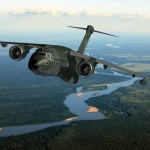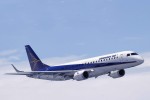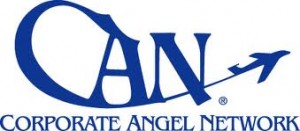FAB and Embraer Announce Plan for KC 390 Initial Acquisition
July 21, 2010
Brazilian Air Force intends to acquire 28 of the series aircraft
São José dos Campos, July 21, 2010 – Embraer and the Brazilian Air Force (FAB) announced
today, in a press conference at the 47th Farnborough International Airshow, in England, FAB´s
intention of making a future purchase of 28 KC-390 aircraft . The development program for the
new military jet transport was signed by FAB and Embraer in April 2009 during the seventh
edition of Latin America Aero and Defence (LAAD) in Rio de Janeiro.
“The Brazilian Air Force has been Embraer’s most important strategic partner since the
Company was founded in 1969,” stated Orlando José Ferreira Neto, Embraer Executive Vice
President – Defense Market. “This announcement reinforces Embraer´s motivation and
commitment to conceive a state-of-the-art product that should exceed FAB requirements and
overall market expectations.”
The project is moving ahead according to plan and the preliminary studies phase was
successfully concluded. The first flight of the airplane is expected for 2014 and entry into
service for the end of 2015. The most relevant wind tunnel tests campaigns have been
concluded, allowing aerodynamic, structural and system configurations freezing.
The KC 390 cargo capacity should exceed the initial requirement and achieve 23.6 tons. A
full-size model of the cargo hold was built to assess the aircraft internal space and typical cargo
operations. The results of these evaluations have confirmed the aircraft’s great versatility.
The KC-390 will feature Computed Air Release Point (CARP) technology integrated with the
fly-by-wire system, which will bring greater accuracy to air dropping while lowering
crewworkload. The airplane will incorporate a modern avionics system, including two Head-
Up Displays (HUD) and a complete self-defense system. The KC-390 operation will be fully
compatible with Night Vision Goggles (NVG) technology.
Faster than its competitors, the aircraft will be capable of operating from short and semiprepared
runways. Included in its mission portfolio are troops and cargo transportation in
diverse and challenging environments such as the Antarctica and Amazon regions, in-flight
refueling, search and rescue (SAR) and medical evacuation (MEDEVAC).
Bell Helicopter Introduces Low-Cost Ground Velocity Sensor for Hover-Hold and SAR Missions
July 21, 2010
FARNBOROUGH, ENGLAND (July 20, 2010) – Bell Helicopter, a Textron Inc. (NYSE: TXT) company, working in cooperation with Esterline CMC Electronics, has developed and flight tested a new generation global positioning system (GPS) sensor to replace existing high-cost Doppler or inertial velocity sensors used in automated approach-to-hover and hover-hold systems.
This new product is anticipated to be available for installation on the Bell 412EP within the next 12-months with plans to expand availability to other models.
“The CMC GPS solution proved more responsive in flight test than both the legacy Doppler and any of the GPS-aided inertial solutions being examined when tied to the existing 412EP autopilot, but this is not just for SAR and hover-hold,” said Bell’s chief technology officer, Nick Lappos. “We see this technology and the capability it brings as a means to improve safety in low-speed operations in general as well as reduce the cost of SAR operations.”
The Bell-CMC low-cost ground velocity sensor is a fraction of the cost of previous technologies. Designed to work with the existing autopilot systems the Bell-CMC ground velocity sensor provides law enforcement and emergency medical service (EMS) operators with significant SAR safety enhancements at an affordable price.
This new offering will provide immediate benefit for Bell 412EP operators by reducing weight, minimizing installation requirements, and improving stabilized hover-hold performance. Unaffected by glassy water, tall grass, under-slung objects or other situations, the new Bell-CMC sensor avoids many operational constraints that have traditionally challenged the performance of Doppler systems.
Established as a as a stand-alone software upgrade to the Esterline CMC Electronics CMA-5024 satellite based augmentation systems (SBAS) GPS receiver, the new Bell-CMC low-cost ground velocity sensor processes a specific property of the raw GPS signals to produce an actual velocity measurement versus reporting changes in GPS positions over time.
Taking advantage of the processing power and high-update rate of the CMA-5024, and not being limited to WAAS/SBAS coverage, the system’s ground velocity function is usable world-wide.
“At Bell Helicopter we are committed to providing our customers with innovative solutions to support their mission requirements,” said Lappos. . “We are confident that this product will directly benefit our customers and look forward to working with industry on future capabilities and safety initiatives.”
Rockwell Collins, Bombardier Unveil Enhanced Cabin Electronics System for Global 5000 and Global Express XRS
July 21, 2010
FARNBOROUGH, UK (July 21, 2010) – Rockwell Collins and Bombardier Aerospace announced
today the release of “V7” Cabin Electronics System (CES) software for operators of Bombardier’s
Global 5000* and Global Express* XRS* business aircraft. The new software includes dozens of
improvements to enhance the look and feel of the system.
The software — which Rockwell Collins co-developed with Teague, a leading industrial design firm
— features a new Graphical User Interface (GUI) with improved intuitiveness and ease of use.
The interface includes an internationally recognized icon-based menu that is less dependent on
language, reflecting advances in modern user interface design.
The new GUI streamlines functionality, bringing the most important features and tasks to the
forefront, while updating the overall look and feel with enhanced graphics. “At a Glance” and
“Favorites” menu options create more universal appeal and make the GUI more immediately
usable.
“As the pinnacle of our team’s efforts to refresh and simplify the GUI, our CES software upgrade
presents a substantial improvement in our market-leading CES capabilities,” said Tommy
Dodson, vice president and general manager of Cabin Systems for Rockwell Collins. “In focus
group testing, Global aircraft operators indicated that our new interface is sleek, user-friendly
and reflective of a world-class cabin experience.”
Stéphane Leblanc, Vice-President, Global Completion Centre, Bombardier Business Aircraft, said
that “all new aircraft deliveries will include the new V7 CES software as of July 2010.”
Rockwell Collins and Bombardier will begin rolling out V7 CES and retrofitting in-service aircraft
later this fall. The software itself will be offered free of charge for most in-service aircraft
(subject to configuration approval).
Sikorsky Innovations Introduces X2 Technology™ Light Tactical Helicopter Simulator
July 21, 2010
July 21, 2010
STRATFORD, Conn. — Sikorsky Innovations, the technology development organization of Sikorsky Aircraft Corp., has unveiled an X2 TechnologyTM Light Tactical Helicopter (LTH) simulator that will provide potential customers with a tangible experience of the significant benefits of X2 Technology. Sikorsky is a subsidiary of United Technologies Corp. (NYSE:UTX).
X2 Technology combines an integrated suite of technologies to advance the state-of-the-art, counter-rotating coaxial rotor helicopter. It is designed to demonstrate that a helicopter can cruise comfortably at 250 knots while retaining such desirable attributes as excellent low-speed handling, efficient hovering, and a seamless and simple transition to high speed. Sikorsky introduced the X2 Technology demonstrator in 2005, and the program has been steadily progressing through flight testing with the goal of achieving the 250-knot speed later this year.
Among the innovative technologies the X2 Technology demonstrator employs are fly-by-wire flight controls, counter-rotating rigid rotor blades, hub drag reduction, active vibration control, and an integrated auxiliary propulsion system.
“The X2 LTH simulator will demonstrate the military application of the capabilities that we are proving out with our X2 Technology demonstrator,” said Teresa Carleton, Vice President, Mission Systems Integration. “With the simulator, we can fly a light tactical helicopter variation of the X2 Technology demonstrator through various mission scenarios, and demonstrate the advantages of speed, high agility, low acoustic signature, and low vibrations. It will be a tremendous, mobile tool that we can bring to potential customers to give them a ‘hands on’ sense of the flight and mission advantages we are bringing to the aviation landscape.”
As the simulator program progresses, it will be enhanced to allow integration and demonstration of technologies that support advanced mission tactics, manned–unmanned teaming, and the optionally piloted helicopter program that Sikorsky Innovations is developing.
Saudi Arabia’s Ministry of Interior Signs Contract for 12 S-76D™ Helicopters
July 21, 2010
July 21, 2010
FARNBOROUGH AIR SHOW, London, England — Sikorsky Aircraft Corp. announced today that the Kingdom of Saudi Arabia’s Ministry of Interior (MOI) has signed a contract to procure 12 S-76DTM helicopters and has taken options to acquire eight additional S-76D aircraft. Sikorsky is a subsidiary of United Technologies Corp. (NYSE:UTX).
The aircraft will perform security, transport and other missions. Delivery of the first helicopter is scheduled for early 2012.
“We’re truly honored to work with the MOI and proud to be announcing the largest S-76D fleet order to date,” said Shane Eddy, vice president of Sikorsky Global Helicopters. “We appreciate the opportunity to show that the S-76D helicopter will provide the superior performance and capability that the MOI requires and is well-suited for operations throughout the region.”
The S-76D helicopter is the latest model in the highly successful S-76® helicopter line. Sikorsky has produced and delivered nearly 800 S-76 helicopters. Among the S-76D helicopter’s features are all-composite, flaw-tolerant main rotor blades; an advanced Thales avionics system and autopilot; dual rotor speed for quiet mode operation with active vibration control; powerful Pratt & Whitney 210S engines; a quiet mode; and an optional Rotor Ice Protection System (RIPS) for all-weather capability. The S-76D helicopter also will offer an increase in useful load and extended range performance versus the S-76C+TM and S-76C++TM aircraft currently fielded.
CHC AW139 Helicopter Achieve 5,000 Hours Milestone
July 21, 2010
AgustaWestland, a Finmeccanica company, is pleased to announce that an AW139 medium twin helicopter operated in the Netherlands by the CHC Helicopter group of companies is the first to achieve the milestone of 5,000 flying hours. CHC is the largest AW139 operator worldwide with 34 units in service or on order. CHC introduced the AW139 into service in 2005 as part of its fleet renewal and expansion plans and the aircraft is now performing roles such as offshore transport, emergency medical service and search and rescue around the world.
Emilio Dalmasso, Senior Vice President Commercial Business Unit, AgustaWestland said, “We congratulate CHC on becoming the first operator to achieve this milestone, which is particularly notable given the demanding operational and environmental conditions encountered supporting oil and gas facilities in the North Sea. Achieving so many flight hours in such a short period is evidence of the effectiveness, safety and reliability of the AW139 and our commitment to support offshore operator’s requirements.”
The best selling and only new generation helicopter in its class available today, the AW139 has set new standards in its category thanks to its outstanding performance in the most demanding conditions, cabin space, payload, state-of-the-art technology, safety, reliability and maintainability. The AW139 has become the benchmark helicopter in the offshore transport market with over 30% of orders logged so far being in this sector of the market. Over 460 AW139 helicopters have been sold with over 300 now in service, many with the world’s leading large fleet operators.
In 2009 AgustaWestland and Heli-One, the maintenance division of CHC, established a worldwide service centre network plus a Repair & Overhaul Centre at Heli-One’s headquarters in Vancouver, Canada.. These agreements have strengthened the support capabilities for the AW139 and build upon AgustaWestland’s ongoing commitment to deliver increasing levels of support to its customers.
CHC Helicopter is a leading player in the provision of helicopter support to the oil and gas industry as well as a world leader in search and rescue (SAR), and repair and overhaul (R&O) markets. CHC Helicopter has bases across all continents with approximately 250 aircraft operating in 35 countries.
Embraer and Air Lease Close an Agreement for up to 20 E-Jets
July 21, 2010
New leasing company opts for the EMBRAER 190
São José dos Campos, July 20, 2010 – Embraer and Air Lease Corp., a newly formed aircraft leasing, purchasing and financing provider
company led by the legendary Steven Udvar-Házy, signed a Letter of Intent (LOI) for the sale of 15 EMBRAER 190 jets, today, at the 47th
Farnborough International Airshow, in England. Five of the 15 orders are re-confirmable, and the deal also includes five options, representing a
potential sale of 20 EMBRAER 190s. “We’re proud to partner with Steven Udvar-
Házy, the founder of Air Lease Corp., in his new, thrilling aviation endeavor,” states Paulo
César de Souza e Silva, Embraer Executive Vice President, Airline Market. “His
remarkable professional experience and respectability in the aviation business, together
with the outstanding attributes of our E-Jets family, will be major supporters of the successof the new company.”
The EMBRAER 190 is the third of the four members of the EMBRAER 170/190 family of E-Jets, a brand-new commercial aircraft that entered service in August 2005. The jet may be configured in one or two classes, seating 98 to 114 passengers in a comfortable four-abreast (2-2), no-middleseat configuration, and can fly up to 2,400 nautical miles (4,448 kilometers) nonstop.
“We have been following the growing market demand for the EMBRAER 190 for many years.
We are now absolutely convinced that it is the right aircraft for not only the regional jet
marketplace, but that it’s powerful and compelling economics, passenger appeal, and
reliability, positions it to occupy a significant segment of mainline operations,” says John L. Plueger, President and COO of Air Lease Corp. “We are delighted to bring this product to our operating lease portfolio for the benefit of our customers, worldwide.”
LAN signs Memorandum of Understanding for 50 A320 Family aircraft
July 21, 2010
LAN’s Airbus orders to rise to over 150
LAN Airlines, one of Latin America’s leading passenger and cargo airlines, announced today its intention to order 50 new eco-efficient Airbus A320 Family aircraft. The Memorandum of Understanding – signed today at the Farnborough International Airshow – will be the largest single airline order for Airbus in Latin America and brings LAN’s total Airbus orders to 152 aircraft.
The commitment includes 10 A321s, a new aircraft type for LAN. The airline’s request for incremental A320 Family aircraft is part of LAN’s growth strategy for Latin America. The aircraft will serve as new and replacement aircraft for both existing and new routes.
Ignacio Cueto, LAN Airlines’ Chief Operating Officer, commented: “We confirm our commitment to the development of commercial aviation in Latin America, incorporating the best technology and offering our customers one of the world’s most modern fleets. We continue investing in order to contribute to the economic growth and social development of the countries in the region.”
“The LAN and Airbus partnership in Latin America has really prospered in the last 12 years. We are convinced that our benchmark aircraft will further advance LAN’s leadership position in the region,” said John Leahy, Airbus Chief Operating Officer, Customers. “We appreciate LAN’s strong and clear vote of confidence in Airbus and look forward to many more years of continued collaboration.”
LAN placed a firm order for 30 single-aisle Airbus A320 Family aircraft in December 2009. The airline currently operates 58 Airbus aircraft.
With almost 500 aircraft sold and a record backlog of more than 200 aircraft to be delivered to its Latin American customers, today more than 370 Airbus aircraft are flying with 23 Latin American airline customers and operators, representing more than 40 percent of the fleet in service.
Sikorsky Innovations Achieves First BLACK HAWK™ Helicopter Autonomous Formation Flight
July 21, 2010
FARNBOROUGH AIR SHOW, London, England -– The first flight of the Sikorsky Autonomous Formation Flying (AFF) system was carried out on June 4 by Sikorsky Innovations, the technology development organization of Sikorsky Aircraft. Sikorsky is a subsidiary of United Technologies Corp. (NYSE:UTX).
The demonstration used the Sikorsky AFF system implemented on the U.S. Army Aeroflightdynamics Directorate’s (AFDD) JUH-60A RASCALTM aircraft, flying in formation with an unmodified EH-60L aircraft. The AFF Project is aimed to reduce a helicopter pilot’s workload by automating routine formation flight. The AFF system will allow a pilot to designate a lead aircraft and engage the system to maintain flight at a specified relative position.
“The AFF control system is the first in a series of demonstrations showcasing Sikorsky Aircraft’s competence in autonomy,” said Mark Miller, Vice President of Engineering. “This is the first in a series of planned technology demonstrations that highlight our capabilities in key areas to promote autonomous flight, including, sensing, control, and system integration.”
The AFF system demonstrated is completely passive, as it uses a single visual range camera and requires no modifications in the lead aircraft, thus placing no special requirements on the aircraft. It can be used to follow an unmodified BLACK HAWK helicopter or modified to follow another type of helicopter.
The AFF control system is another example of new capabilities enabled by fly-by-wire technology (FBW), and is another in a series of demonstrations that highlight the importance of FBW and the new capabilities it brings to the customer.
Bombardier Adds Four Global Express XRS Jets to Its Order Book
July 21, 2010
FARNBOROUGH, UNITED KINGDOM–(Marketwire – July 20, 2010) – Bombardier Aerospace today announced that it received firm orders for four Global Express XRS jets from undisclosed customers based in Russia. The total value of the orders is approximately $213 million US, based on the 2010 list price for typically equipped aircraft.
“The Global aircraft family is renowned for its superior level of performance and comfort and this announcement further emphasizes that Global jets remain in high demand,” said Bob Horner, Senior Vice President, Sales, Bombardier Business Aircraft.
<








